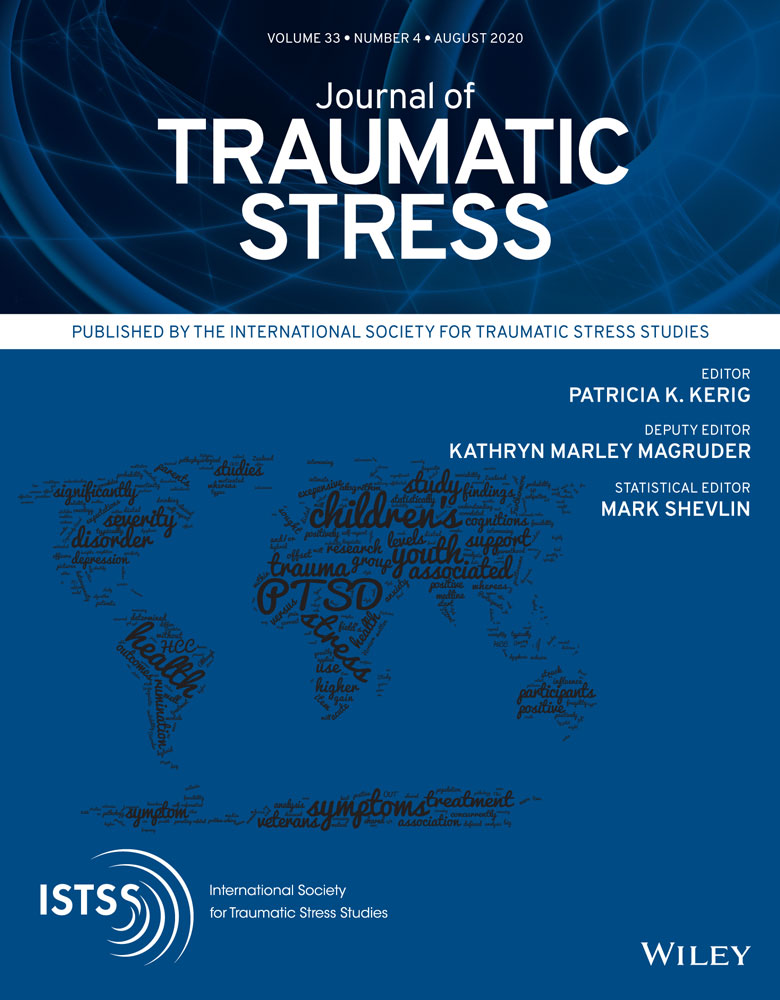Commentary on the Special Issue on Moral Injury: Leveraging Existing Constructs to Test the Heuristic Model of Moral Injury
Alyson Zalta's contribution was supported by a training grant from the National Institute of Mental Health (K23 MH103394). Philip Held is supported by a career development award from the National Institute of Health's National Center for Advancing Translational Sciences (5KL2TR002387-02) and receives grant support from Wounded Warrior Project and the Boeing Company. The content is solely the responsibility of the authors and does not necessarily represent the official views of the National Institutes of Health, the National Center for Advancing Translational Sciences, or other funders.
Abstract
enThe literature on moral injury (MI) is currently undermined by the lack of clear boundaries regarding the construct and a dearth of research on the processes by which potentially morally injurious events lead to MI. The heuristic continuum model of moral stressors proposes ways of distinguishing between moral frustrations, moral distress, and MI. In this commentary, we highlight five testable principles that can be derived from the heuristic model and evaluated using well-established constructs. Specifically, we describe meaningful distinctions between guilt and shame and address how these moral emotions can be used to distinguish between moral distress and MI. We also describe the potential role of event-related rumination, shame proneness, and cognitive flexibility in the development of MI following exposure to potentially morally injurious events. We believe that these principles offer critical next steps for the advancement of the MI field and illustrate how MI research can be generalized beyond the military context.
Resumen
esJOTS- 19-0423
Spanish Abstracts by Asociación Chilena de Estrés Traumático (ACET)
Comentario sobre el Número Especial de Daño Moral: Aprovechando los Constructos Existentes para Probar el Modelo Heurístico de Daño Moral
PROBANDO EL MODELO HEUTISTICO DE DAÑO MORAL
La literatura en daño moral (DM) está actualmente debilitada por la carencia de límites claros con respecto al constructo y una escasez de investigación sobre los procesos por los cuales los eventos potencialmente dañinos moralmente llevan al DM. El modelo continuo heurístico de los estresores morales propone formas para distinguir entre las frustraciones morales, el estrés moral, y el DM. En este comentario, enfatizamos los cinco principios comprobables que pueden ser derivados desde el modelo heurístico y evaluados usando constructos bien establecidos. Específicamente, describimos las distinciones significativas entre culpa y vergüenza y abordamos cómo estas emociones morales pueden ser usadas para distinguir entre la angustia moral y el DM. También describimos el rol potencial de la rumiación relacionada al evento, tendencia a la culpa, y la flexibilidad cognitiva en el desarrollo del DM luego de la exposición a eventos potencialmente dañinos moralmente. Creemos que estos principios ofrecen los próximos pasos críticos para el avance del área del DM e ilustra cómo la investigación del DM puede ser generalizada más allá del contexto militar.
抽象
zhTraditional and Simplified Chinese Abstracts by the Asian Society for Traumatic Stress Studies (AsianSTSS)
簡體及繁體中文撮要由亞洲創傷心理研究學會翻譯
Commentary on the Special Issue on Moral Injury: Leveraging Existing Constructs to Test the Heuristic Model of Moral Injury
Traditional Chinese
標題: 有關道德創傷特刊的評論:借助現存構念來測試道德創傷的捷思模型
撮要: 目前, 有關道德創傷(MI)的文獻對構念欠缺清晰的定義, 亦欠缺研究檢視潛在違反道德的事件導致道德創傷的過程。道德壓力源的捷思運作模型, 提出了辨識道德沮喪、道德悲痛和MI的方法。本評論文章專注討論五個從捷思模型得出可測試的原理, 及評估採用已知構念的效果。我們特別描述了內疚和羞恥的分野, 並討論這些道德情緒可如何用以區分道德悲痛和MI。我們亦描述在經歷違反道德的事件後, 事件相關的反芻、羞恥傾向、認知彈性在MI發展中的潛在作用。我們相信, 這些原理為未來的MI研究提供了關鍵的線索, 亦闡釋了MI研究可如何超越軍事環境進一步普及化。
Simplified Chinese
标题: 有关道德创伤特刊的评论:借助现存构念来测试道德创伤的捷思模型
撮要: 目前, 有关道德创伤(MI)的文献对构念欠缺清晰的定义, 亦欠缺研究检视潜在违反道德的事件导致道德创伤的过程。道德压力源的捷思运作模型, 提出了辨识道德沮丧、道德悲痛和MI的方法。本评论文章专注讨论五个从捷思模型得出可测试的原理, 及评估采用已知构念的效果。我们特别描述了内疚和羞耻的分野, 并讨论这些道德情绪可如何用以区分道德悲痛和MI。我们亦描述在经历违反道德的事件后, 事件相关的反刍、羞耻倾向、认知弹性在MI发展中的潜在作用。我们相信, 这些原理为未来的MI研究提供了关键的线索, 亦阐释了MI研究可如何超越军事环境进一步普及化。




